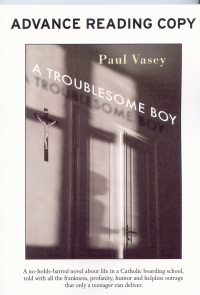| ________________
CM . . . . Volume XVIII Number 27 . . . . March 16, 2012

 |
A Troublesome Boy.
Paul Vasey.
Toronto, ON: Groundwood Books/House of Anansi Press, 2012.
225 pp., trade pbk., hardcover & e-book, $9.95 (pbk.), $16.95 (hc)., $9.95 (e-book).
ISBN 978-1-55498-155-7 (pbk), ISBN 978-1-55498-154-0 (hc.), ISBN 978-1-55498-201-1.
Grades 8-12 / Ages 13-17.
Review by Rob Bittner.
***½ /4
Reviewed from Advance Reading Copy.
|
| |
|

excerpt:
I was almost fourteen and a half and already I was a failure. Capital A. Capital F. Don’t take my word for it. Take the word of pasty-faced, pudgy-fingered, owl-eyed Gordon Little, head of guidance at Avery Bay Collegiate and Vocational Institute.
Words, actually, lots of them. Written in his old-lady fountain-pen handwriting on his pansy blue stationery and stapled to my report card so there’d be a telltale hole in the card if I ripped off the note and tossed it into the garbage where it obviously belonged.
“Teddy is A Troublesome Boy. He is Disrespectful of his Teachers and Dismissive of his Classmates. He has A Major Problem with Persons in A Position of Authority. He is constantly challenging his Teachers and belittling the opinions of his Peers. Although he is undoubtedly An Intelligent Boy, he is A Failure when it comes to applying himself to his studies. As you can see, he has failed every course in Grade 9, with the exception of Art. We here at A.B.C.V.I are at A Loss. Perhaps you are considering Another Course of Action. Please Advise.”
Teddy is A Troublesome Boy, at least according to his teachers and his mother’s new boyfriend. When the boyfriend decides to send Teddy to St. Ignatius, a Catholic boarding school, there is nothing Teddy can do to change his situation. From his first moments in the school, which smells of “heavy-duty industrial cleaner” and looks “exactly like a prison,” Teddy realizes he is in a whole other world than he was previously used to. Within moments, he finds himself locked in a time-out room—nicknamed The Dungeon by the other boys—where he must sit alone, in the dark, for however long the Fathers decide. It does not take long before Teddy to begin planning his escape. His disappearance is delayed, however, after he meets and befriends another boy, Timothy Cooper.
Teddy begins to notice the abusive and disturbing side of the Fathers soon after his arrival, noting how many boys end up having to relieve themselves in The Dungeons when the Fathers forget to let them out, or how one boy ended up in the hospital when his face was smashed into a wall during class for talking back. The worst, though, is Father Prince. Teddy notices that most nights after the boys have started to fall asleep in their dorms, Father Prince comes in and calls on Cooper to come with him. Soon after, Teddy notices how Timothy Cooper’s attitude is changing and how often Cooper sits by himself, scribbling intently in the margins of a book of Wordsworth poems.
The abusive and disturbing nature of the 1959 Catholic boarding school is vivid and dark, told brilliantly through 14-year-old eyes. Teddy’s experiences trying to navigate the unpredictable maze of discipline and abuse is eye-opening but also told with wit and humour that helps to alleviate what would otherwise be a truly dark and troubling tale. Another character who brings some much needed compassion and friendliness into the world of the novel is Rozey, a noted “simple” man who is in charge of maintenance and repair around St. Iggy’s campus. Teddy and Timothy befriend Rozey and eventually begin to spend time with him on the weekends, playing games, going fishing, and having holiday meals. Rozey could easily have become a stock character, but Vasey does a marvelous job giving him great depth and a compelling back story.
By far the darkest and saddest character is Timothy, a boy without a father, and without a mother who cares for him, left in foster care and eventually sent to St. Iggy’s where he is drawn into the web of Father Prince. His character is complex, showing both a sensitive side that desires love and acceptance, and a hidden side that just wants to be left alone, wants to slink away into the shadows and stay concealed from the lecherous glances of Father Prince.
Perhaps the most unsettling aspect of the novel is the role of Father Prince as both concerned Father—at least in show—and libidinous villain. When he stands in the locker room watching the boys shower, not even trying to hide his lusty glares, I wanted to knock him down, but had to sit by helplessly and see what he would do. As a reader, this is one of the rare moments that I love and hate. Vasey has created characters that I want to see brought to justice, but they are also so well-formed that I want, at times, to pull my eyes from the page to avoid reading about the heinousness of their actions.
A Troublesome Boy is full of tension, humour, disturbing characters as well as sympathetic ones, a commentary on Catholic schools and the abuse that pupils endured in the 1950s, and a beautifully constructed narrative voice. Vasey’s book is troubling, but with a feeling of hope at the end which leaves its readers unsettled but not entirely discouraged.
Highly Recommended.
Rob Bittner is a graduate of the MA in Children’s literature program at The University of British Columbia in Vancouver, BC.

To comment
on this title or this review, send mail to cm@umanitoba.ca.
Copyright © the Manitoba Library Association. Reproduction for personal
use is permitted only if this copyright notice is maintained. Any
other reproduction is prohibited without permission.
NEXT REVIEW |
TABLE OF CONTENTS FOR THIS ISSUE
- March 16, 2012.
AUTHORS |
TITLES |
MEDIA REVIEWS |
PROFILES |
BACK ISSUES |
SEARCH |
CMARCHIVE |
HOME |
